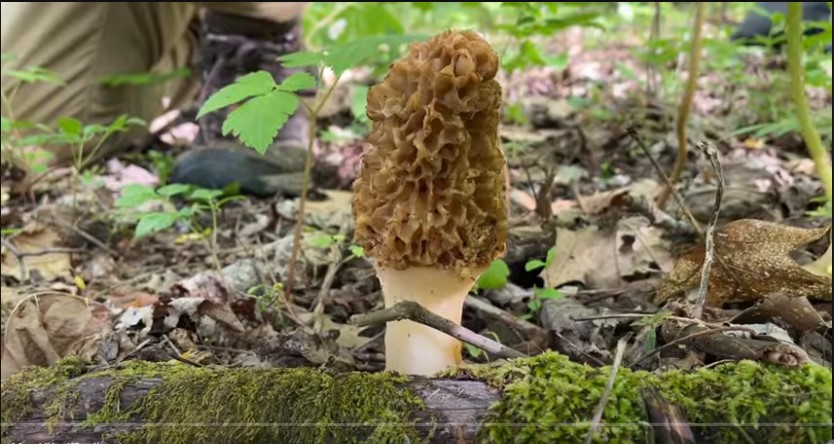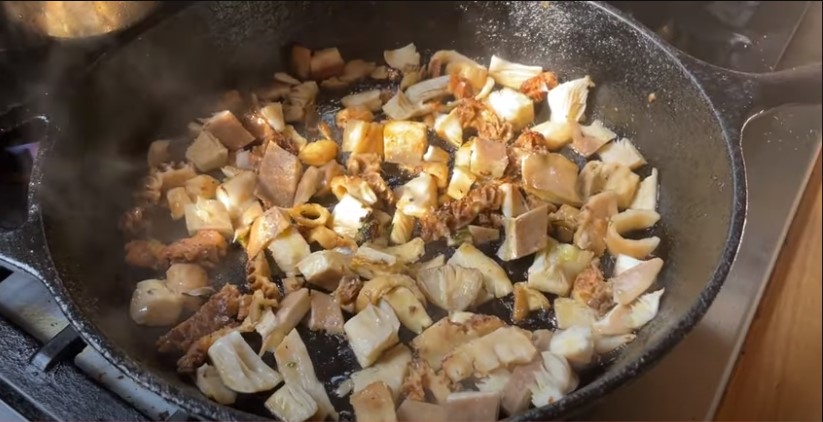As an Amazon Associate, I earn from qualifying purchases

Introduction
Preserving your wild morel mushroom harvest is a rewarding way to enjoy the flavors of nature year-round, and dehydrating morel mushrooms is an excellent method for achieving this. This article will guide you through the process of drying morels and provide tips on storage, usage, and safety.
The Bounty of Wild Morel Mushrooms
Wild morel mushrooms, a forager’s dream, can be elusive and their yield varies annually. Factors like weather conditions play a crucial role in their abundance. This year, owing to a cool and rainy season coupled with burn areas from the previous year, we’ve witnessed an extraordinary morel crop in the inland northwest of the United States.

Wild morels are like a treasure hunt for nature lovers! Finding them can be tricky, and how many you find can change a lot from year to year.
In our region, we usually have morel mushrooms, but some years are better than others. This year has been exceptional, breaking all the records.
Last year was super hot and dry, leading to a big wildfire season, which was not good. But now, the areas that burned last year are full of wild morels.
This year, the weather has been the opposite of last year—very cool and rainy in the inland northwest of the United States. The combination of the cool rain and the burned areas from last year has given us an incredible amount of morels. We’ve gathered over 16 gallons of them in just two days!
Now, dealing with such a huge pile of mushrooms can be a puzzle! I’ve dried a bunch and frozen some to make sure we can enjoy them all year round.
Drying morels is a smart way to keep them. They don’t take up much space and can be stored in the pantry.
Another fantastic way to enjoy your morels is by sautéing them! They make a delicious treat—perfect as an appetizer or alongside a grilled steak
Harvesting Success
In just two days and a few hours, we managed to harvest over 16 gallons of morels. With such a surplus, deciding what to do with them can be challenging. One effective method is drying them, preserving both space and flavor for year-round culinary adventures.
Drying Morel Mushrooms: Step by Step

1. Cleaning the Mushrooms
- Wash the mushrooms in cool water, changing it 2-3 times if necessary.
- Add 1/3 cup of salt to the water to draw out any small bugs or worms.
- Rinse the mushrooms thoroughly with cool water.
2. Slicing and Dehydrating
- Slice the mushrooms in half lengthwise or leave smaller ones whole.
- Place them on a dehydrator tray.
- Dehydrate at 120°F for 8-10 hours until fully dry.
3. Storage
- Store the dried morel mushrooms in a jar or zip-top bag.
- Guarantee the holder is impenetrable to forestall dampness.
- Alternatively, store them in the freezer for extended shelf life.
Drying Tips
- Morels contain a high water content and will significantly shrink when dried.
- Ensure the mushrooms are fully dry before storage.
- Drying time varies based on mushroom size, quantity, and environmental conditions.
- Store dried mushrooms in an airtight container; they should remain good for several years without moisture.
Safety Tips for Consuming Morel Mushrooms
- Properly identify and pick morels; wild mushrooms can be dangerous.
- Never consume morels raw; ensure they are fully cooked before consumption.
- Avoid eating decaying or rotting morels.
How to Use Dried Morels: A Quick Guide
- Soaking: Soak dried morels in hot water for 5-10 minutes until softened.
- Discarding or Adding: Discard the soaking water or add it to soups or braised dishes for added flavor.
- Chopping or Using Whole: Chop the rehydrated morels or use them whole in any recipe that calls for mushrooms.
Nutritional Disclaimer
Nutritional information is provided as an estimate and not a guarantee. For precise nutritional details, calculate using your preferred nutrition calculator with exact ingredients.
How to Find Morels for a Delicious Mushroom Feast
As the warmth of spring graces us with vibrant flowers and gentle breezes, it also unveils a culinary treasure hidden beneath the forest canopy: morel mushrooms. These wild delicacies, priced at $50 per pound fresh and well over $100 per pound dried, are a sought-after treat. Their scarcity, limited to late March through May, and the inability to cultivate them indoors contribute to their exclusivity. Foraging for morels has become a thrilling pursuit for many, and mastering the art of finding these elusive fungi adds an extra layer of satisfaction to the culinary experience.
The Allure of Morels
The distinctiveness of morel mushrooms lies not only in their taste but also in their appearance. Recognizing these mushrooms is crucial, as mistaking them for other varieties can be risky. Genuine morels have cone-shaped caps with intricate crevices, resembling a sponge. When cut open, they reveal a hollow interior. Beware of false morels, which can be dangerous. Distinguish them by their wrinkled caps, often with a shriveled appearance, and a different coloration, usually reddish. Always err on the side of caution; if in doubt, leave them be.
Perfect Timing for Morel Foraging
Successfully finding morels hinges on timing. These mushrooms thrive in moist, slightly cool conditions, typically emerging after spring rainstorms. Keep an eye on the weather, aiming for nights where temperatures stay above 50°F. In the early stages of the season, morels may be tiny, about the size of your thumb. Patience is key, as they grow larger later in spring, sometimes reaching the size of a soda can. Spotting them becomes easier, but be mindful not to wait too long, as other foragers might beat you to the prize.
Where and How to Seek Morels
While luck plays a significant role in morel hunting, seasoned foragers sometimes share their discoveries. Websites like The Great Morel offer interactive maps where enthusiasts mark their find locations. For those venturing on their own, wooded areas, especially around oak, elm, ash, and aspen trees, are prime locations. Focus on the periphery of wooded areas and check around dead or dying trees, as morels often grow near the base.
Areas with recent disturbances, like a forest fire or lightly-used trails, are also worth exploring. Following a small stream or creek might lead to morel hotspots. Once you find a morel, pause and search the nearby area within 20 feet, as these mushrooms tend to grow in clusters. Harvesting is simple; cut them at the base with scissors or a knife, or snap them off with your fingers.
The Joy of Morel Mushroom Hunting
While the thrill of the search is undeniable, the real delight comes from savoring the flavors of your bounty. If you’re fortunate enough to stumble upon morels, enhance your culinary experience by cooking them first. Whether topping a pizza or sautéing with butter, the unique flavor of morels is a reward worth relishing.
Frequently Asked Questions
How fast do morel mushrooms grow?
Morel mushrooms reach full maturity and become ready for picking within 10 to 15 days after emerging from the ground. Their tiny heads may seem to appear overnight.
Which states are morel mushrooms most commonly found?
Morels can be found in nearly every state, with Tennessee, Michigan, Wisconsin, Oklahoma, and Vermont being the top contenders each spring. Locations with recent wildfire burns are often prime spots for morel foraging.
Can you grow morel mushrooms in your own garden or yard?
Growing morels in your yard requires specific conditions. Utilize decayed wood in a shady, damp area, or consider commercially available morel kits that provide the necessary spores for cultivation.
embarking on a morel mushroom foraging adventure is not only a culinary escapade but also an opportunity to connect with nature. Armed with knowledge about identification, timing, and suitable locations, you’re ready to elevate your springtime experiences with the thrill of finding these elusive and delectable treasures. Happy foraging!
Conclusion
In conclusion, dehydrating morel mushrooms is a simple yet effective way to extend the joy of foraging. Whether you savor them in soups, stews, or braised dishes, the preserved flavor of morels will elevate your culinary creations. Happy foraging and happy cooking
In the quest for morel mushrooms, the temporal conundrum unfurls: when do these elusive fungi grace the world with their presence? Steve, my progeny, espouses a botanical enigma, declaring, “When the verdant tendrils of asparagus emerge, the moment for morel hunting dawns.” In the realms of southeastern Pennsylvania, one ought to cast their gaze upon the earth from mid-April to mid-June, where the Morel symphony orchestrates its crescendo.
For the intrepid forager, the Great Morel sighting maps stand as an invaluable compendium, guiding one through the temporal ballet of Morel emergence, a roadmap for the initiation of their sylvan odyssey.
Now, the preservation saga unfurls—how does one immortalize the ephemeral allure of morel mushrooms? Should fortune favor your pursuit, and a glut of morels grace your harvest, the preservation alchemy beckons. A symphony of techniques presents itself: the ballet of air-drying, the culinary sonnet of oven-drying, the cryogenic ballet of freezing, and the desiccation minuet of dehydration.
Amongst these, the ascetic elegance of drying emerges as the preferred opus. Swift and facile, it weaves the narrative of preservation with an ease that belies its profundity. The essence lies in simplicity—quintessential and expedient!
visit our website: 500eastsh.com